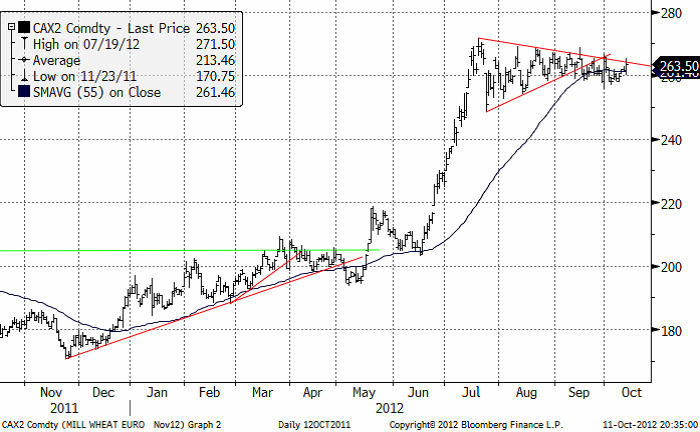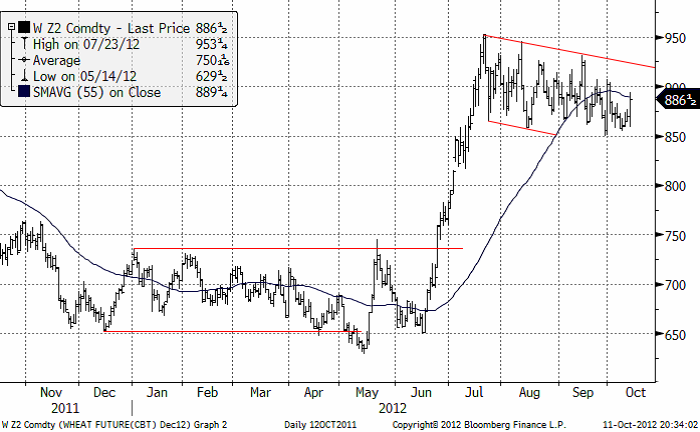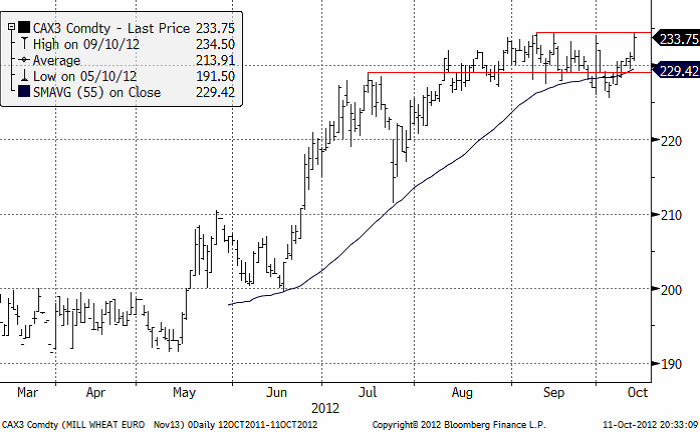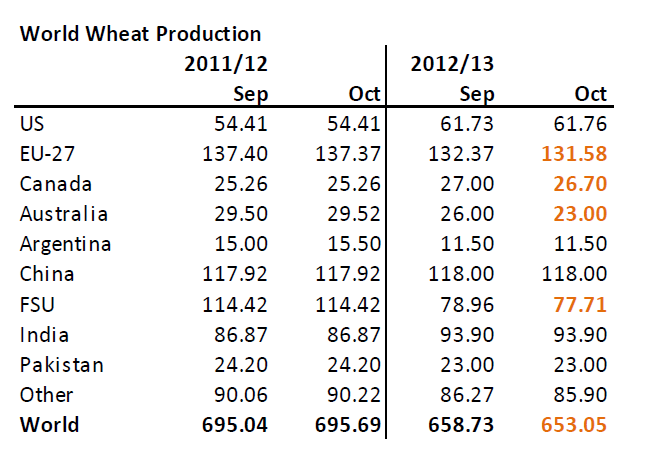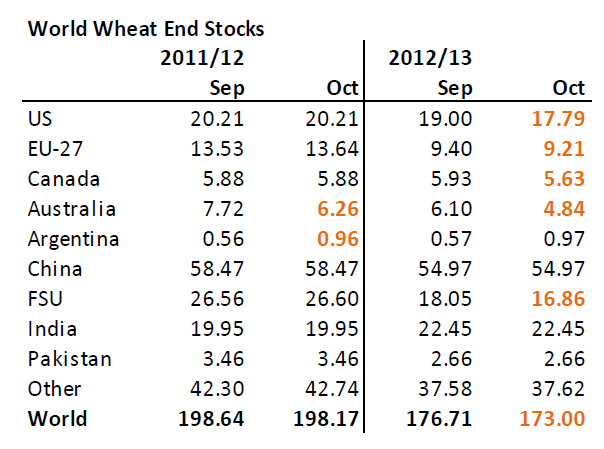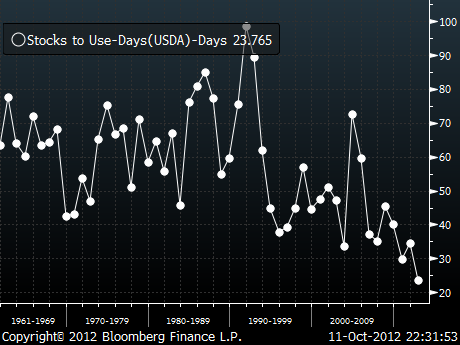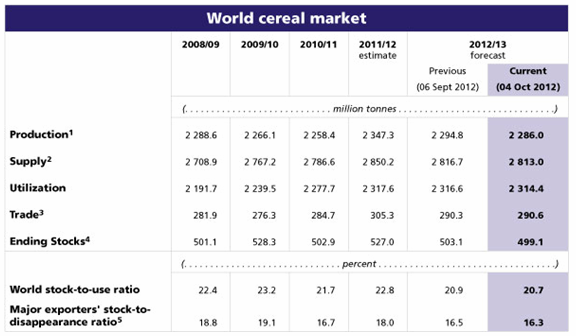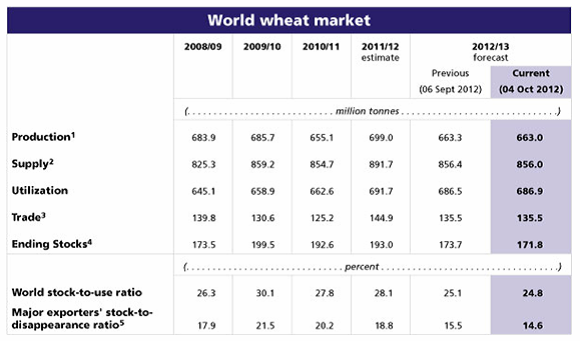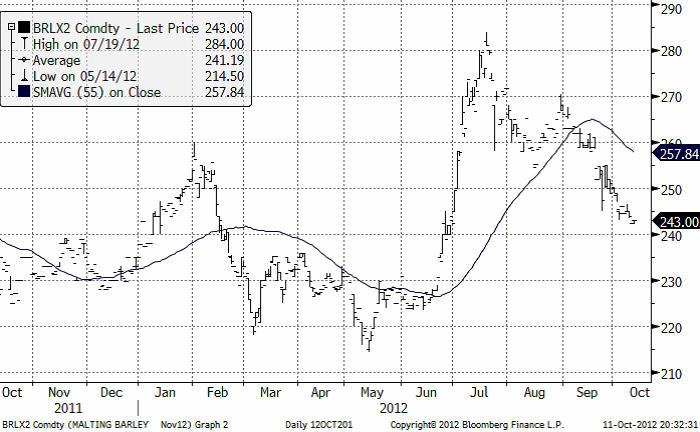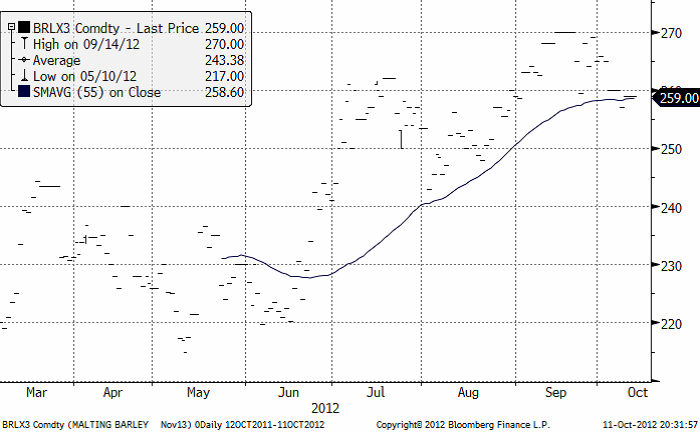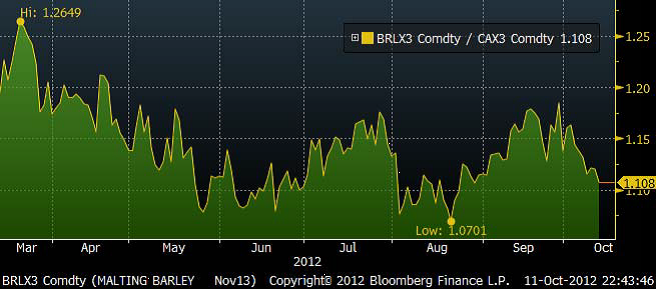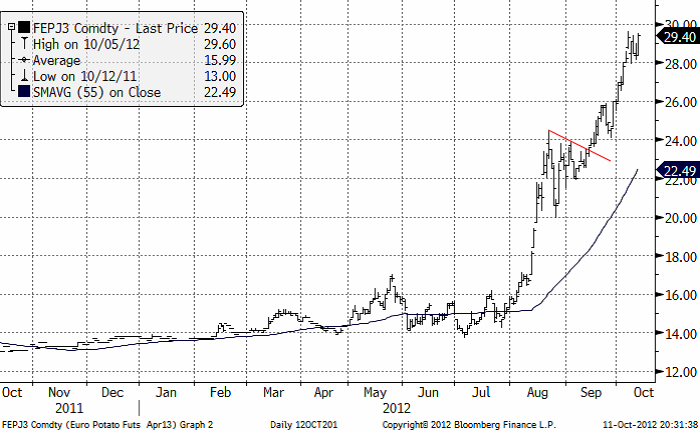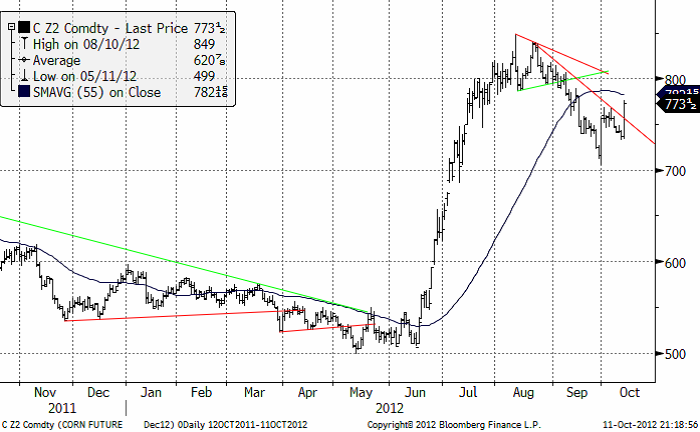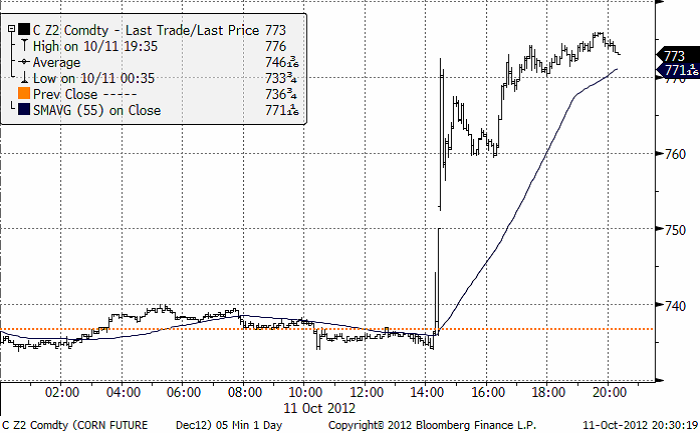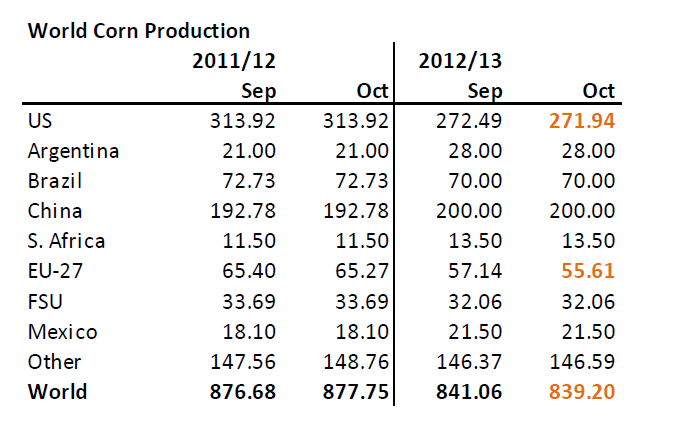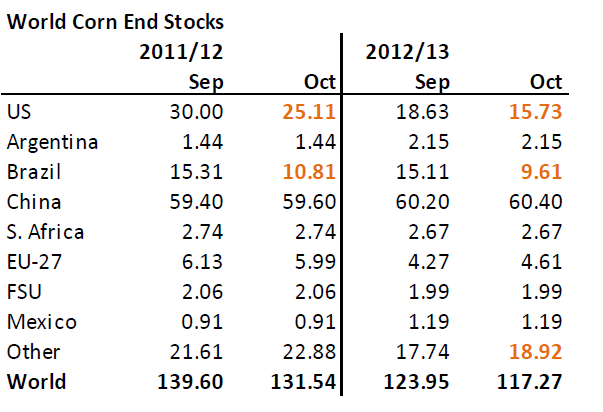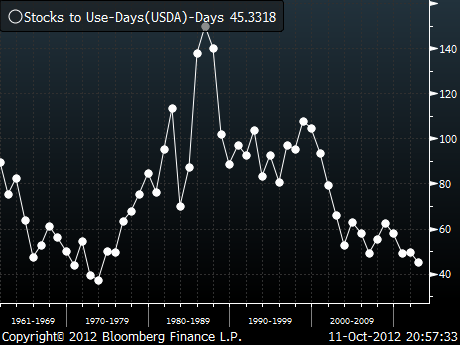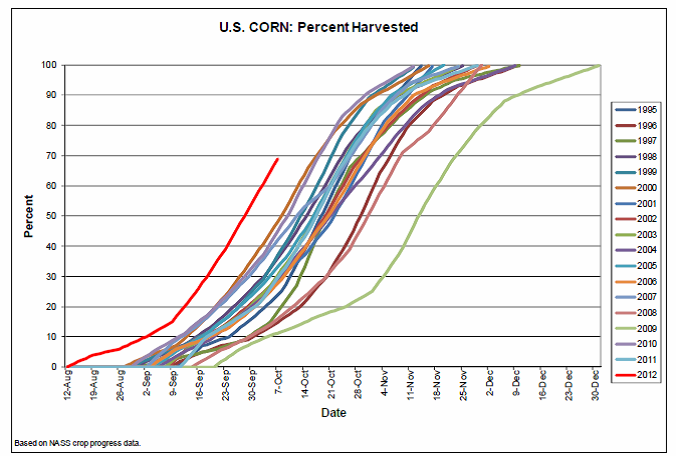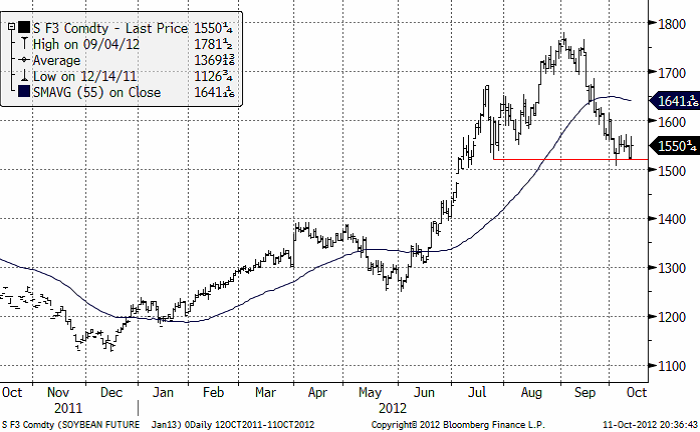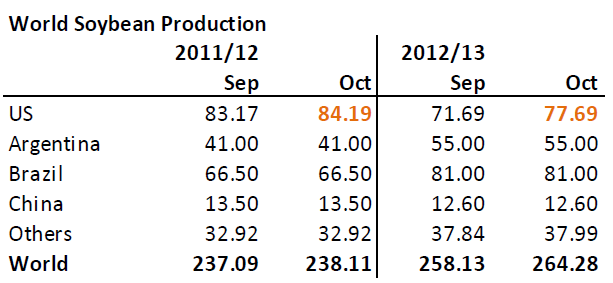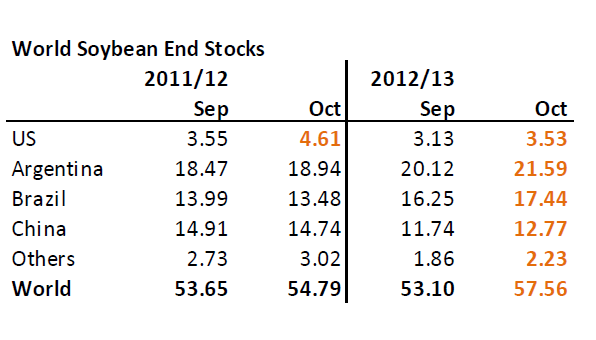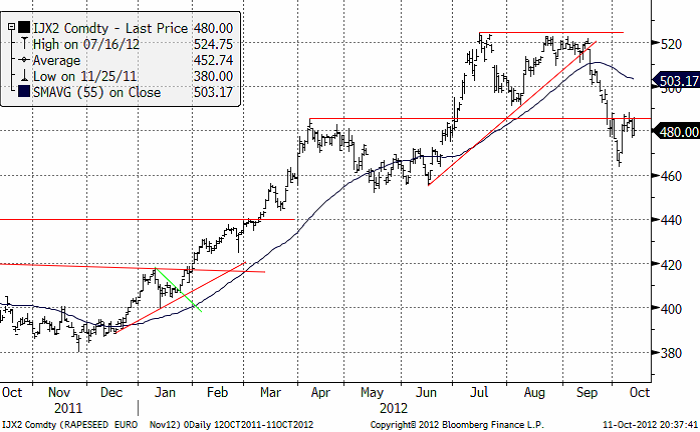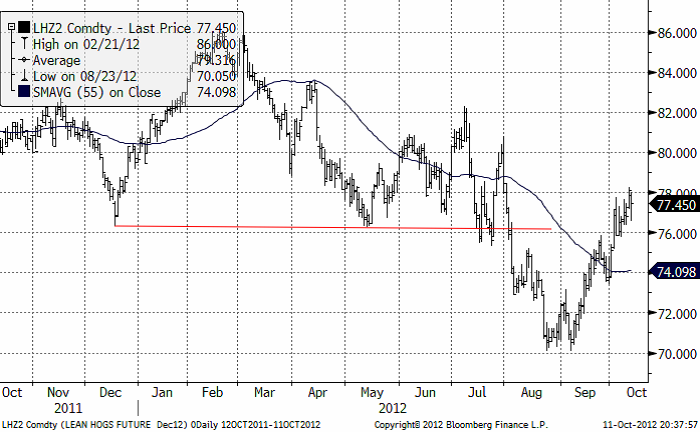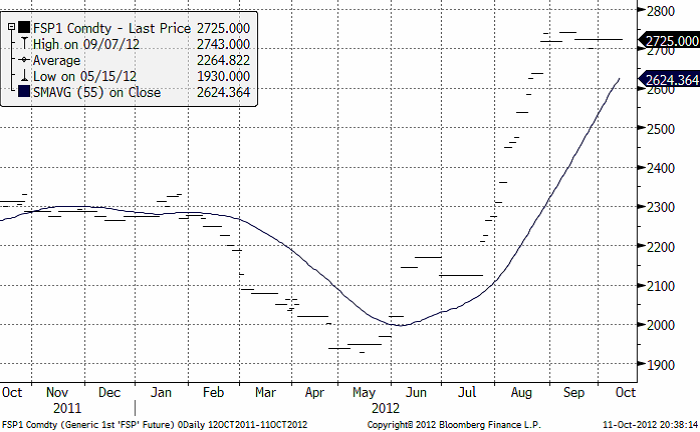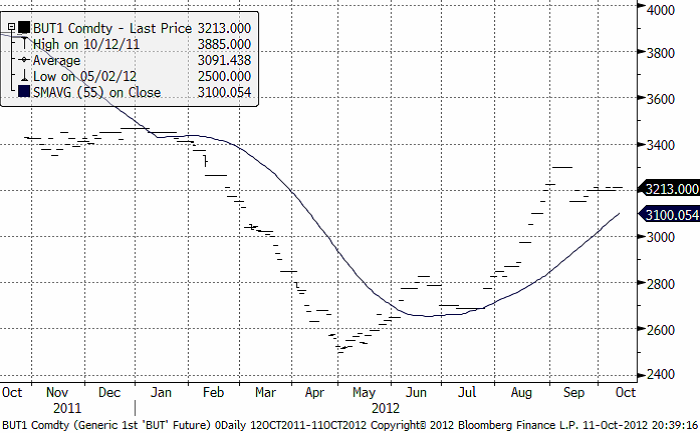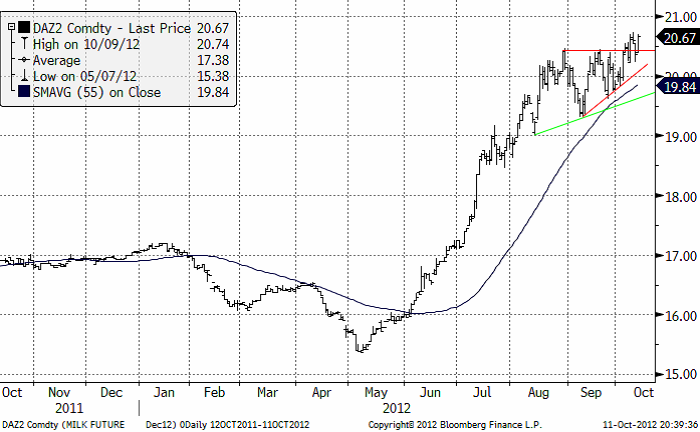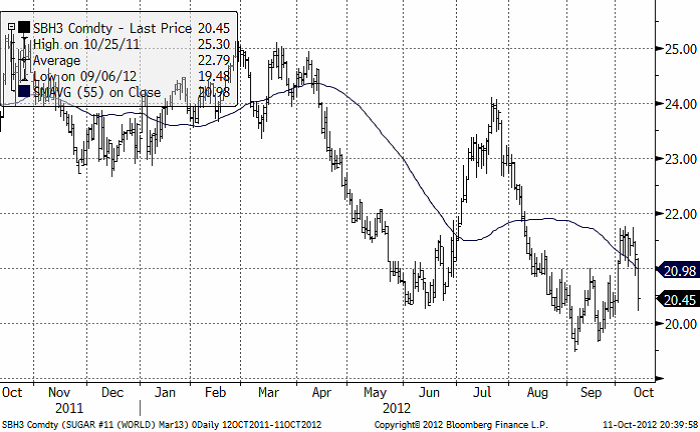Analys
SEB Jordbruksprodukter, 12 oktober 2012
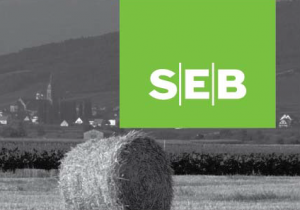 USDA justerade ner prognosen för utgående lager i majs till den lägsta nivån sedan 1973. Innan nästa skörd på norra halvklotet väntas lagren räcka i 45 dagar. 1973 var lagret 37 dagars global konsumtion. Vetelagren i Europa väntas vara på riktigt låg nivå den sista juni. Vi är inte negativa till priset på spannmålen majs, vete och maltkorn, utan neutrala. Vi kan inte avgöra om den ansträngda lagersituationen kommer att leda till högre priser eller om ransonering av efterfrågan kommer att vara tillräcklig.
USDA justerade ner prognosen för utgående lager i majs till den lägsta nivån sedan 1973. Innan nästa skörd på norra halvklotet väntas lagren räcka i 45 dagar. 1973 var lagret 37 dagars global konsumtion. Vetelagren i Europa väntas vara på riktigt låg nivå den sista juni. Vi är inte negativa till priset på spannmålen majs, vete och maltkorn, utan neutrala. Vi kan inte avgöra om den ansträngda lagersituationen kommer att leda till högre priser eller om ransonering av efterfrågan kommer att vara tillräcklig.
För oljeväxter pekar det mesta på lägre priser framöver, och vi behåller vår negativa vy för prisutvecklingen på sojabönor. För raps är vi neutrala. Vi gör alltså ingen annan bedömning efter gårdagens WASDE-rapport, än den vi hade förra veckan.
Odlingsväder
El Niño-signalerna har fortsatt att försvagas och nu förväntas neutrala ENSO-förhållanden under södra halvklotets odlingssäsong. Fru Martell skriver så här i sin senaste rapport:
“Potential consequences of ENSO-neutral conditions (as opposed to El Niño) are listed below:
- Less winter rainfall in US hard red winter wheat (maybe average but not real wet)
- Colder winter in the Northern Plains, Upper Midwest and Western Canada
- Increased rainfall in Australia’s east coast, benefiting wheat development
- Heavy rain potential in Indonesia palm fruit plantations (El Niño causes drought)
- Drier weather in Argentina and South Brazil
- Bouts of summer heat in southern South America (opposite of El Niño coolness)”
Den här ganska stora förändringen i klimatet på jorden, innebär alltså att oljeväxter, t ex sojabönor i Mato Grosso och palmolja i Malaysia får en ökad produktion; negativt för priset. Spannmål, t ex vete i USA, som har ett underskott av markfukt som behöver repareras, missgynnas eftersom det blir ”normal” nederbörd och inte en återställning av markfukten fram till vårens tillväxtfas. Argentina och södra Brasilien är också viktiga produktionsområden för majs och vete och de får då inte den tillväxtfrämjande nederbörden som ett El Niño hade gett dem. Det innebär alltså att priset kan gå högre på dessa produkter.
Vete
Vetemarknaden har fortsatt att röra sig väldigt lite.
Nedan ser vi Chicagovetet med leverans i december. 55-dagars glidande medelvärde är brutet och marknaden står och väger.
Nedanför ser vi prisdiagrammet för Matifs november 2013-kontrakt. Priset har de senaste dagarna fallit av och ligger nu under toppformationens stödlinje och under 55-dagars glidande medelvärde. Det ser ut som om trenden håller på att vända ner. Och naturligtvis, för många spannmålsodlare är det attraktivt att låsa in ett pris för nästa år på en förhållandevis hög prisnivå. Varför ta risken, är det säkert många som tänker, när priserna ändå är på mycket höga nivåer.
Nedan ser vi uppdateringen av global produktion i oktobers WASDE-rapport. Det är en nedjustering på global basis med 5.5 mt. Lite med vad-var-det-jag-sade triumf noterar vi att USDA nu fått justera ner Australiens skörd dit där den ska vara: 23 mt. Så var den här nedjusteringen av global produktion till ca
42.5 mt lägre än förra året förvånande eller inte? Nej, egentligen inte. Det var ungefär som förväntat.
Nedan ser vi utgående lager och där har man sänkt konsumtionen med nästan 2 mt för att få en sänkning med utgående lager med 3.7 mt.
Man har sänkt utgående lager ännu lite till i Europa. Vi ser i diagrammet nedan att utgående lager för Eurozonen den sista juni väntas räcka i 23.8 dagar. Den 24 juli är det tomt i varenda vrå i Eurozonen, med andra ord.
WASDE rapporten har kallats ”tråkig” därför att den var mer eller mindre i linje med förväntningarna. Men den är inte tråkig eftersom lagren är så otroligt låga. Priset ransonerar inte efterfrågan och under våren nästa år kan oron kanske växa en del mer. FAO:s senaste prognos över den globala spannmålsproduktionen 2012 har reviderats ned något sedan förra månadens estimat till 2 286 mt. Den senaste nedjusteringen beror främst på en mindre majsproduktion i de centrala och sydöstra delarna av Europa, och att spannmålsproduktionen i centrala produktionsområden som USA, Europa och Centralasien har påverkats av kraftig torka. De allra första indikationerna för produktionen av vete 2013 ser dock positiva ut, då sådden av höstvete på det norra halvklotet redan har kommit långt som en följd av i allmänhet gynnsamma väderförhållanden.
Den globala konsumtionen av vete beräknas uppgå till 686.9 mt, vilket är en liten minskning från föregående säsong mestadels beroende på minskad foderanvändning efter föregående års exceptionellt höga användning av vete till djurfoder. Globala vetelager estimeras till 172 mt, en minskning med 21 mt (11%) från föregående säsong och nästan 2 mt mindre än FAO:s prognos i september. Lägre lager förväntas främst i Kazakstan, Ryssland och Ukraina, men även i Kina, EU och USA.
Tisdagens Crop Progress visar att sådden av det amerikanska höstvetet går framåt och nu är avklarad till 57%, en ökning med 17% från förra veckan och i stort sett i linje med det femåriga genomsnittet (59%). Sådden är till över 80% klar nu i Colorado och Nebraska och till väl över hälften klar i Montana och South Dakota. Rysslands jordbruksminister uppskattar landets spannmålsproduktion 2012 till 71.0 mt. Exporten av spannmål estimeras nu till 10 mt, men man vidhåller fortfarande att inga officiella exportrestriktioner kommer att behövas. Däremot är vi övertygade om att det är slut senast i december.
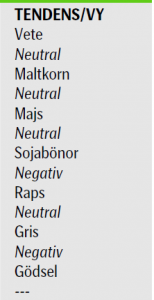 Kazakstans har så här långt skördat 98.9% av landets spannmålsskörd, jämfört med 89% vid den här tiden förra året, med en genomsnittlig avkastning på 0.94 ton/ha. Syriens statliga General Establishment for Cereal Processing and Trade (Hoboob) har köpt 100 000 ton vete från Ukraina, trots svårigheter med att få omvärlden att sälja och transportera spannmål till det krigshärjade landet. FranceAgrimer justerar ned sin prognos för landets vetelager i slutet på denna säsong till 1.8 mt, vilket är en minskning med ca 600 000 ton från förra månadens prognos och den lägsta nivån på minst 13 år, beroende på en reviderad prognos av landets veteexport från 9.0 mt till 9.5 mt.
Kazakstans har så här långt skördat 98.9% av landets spannmålsskörd, jämfört med 89% vid den här tiden förra året, med en genomsnittlig avkastning på 0.94 ton/ha. Syriens statliga General Establishment for Cereal Processing and Trade (Hoboob) har köpt 100 000 ton vete från Ukraina, trots svårigheter med att få omvärlden att sälja och transportera spannmål till det krigshärjade landet. FranceAgrimer justerar ned sin prognos för landets vetelager i slutet på denna säsong till 1.8 mt, vilket är en minskning med ca 600 000 ton från förra månadens prognos och den lägsta nivån på minst 13 år, beroende på en reviderad prognos av landets veteexport från 9.0 mt till 9.5 mt.
Den senaste rapporten från StatsCanada visar på att den totala veteproduktionen förväntas uppgå till 26.7 mt under 2012, en ökning med 5.8% från 2011. Avkastningen för vete i Storbritannien i år har varit den lägsta sedan slutet på 1980-talet enligt en undersökning gjord av NFU (National Farmers Union) hos dess medlemmar. Efter en sommar med ihållande regn och skyfall vid vissa tillfällen så förväntas avkastningen att sjunka med 14.1% (från 7.8 till 6.7 ton per hektar) jämfört med det femåriga genomsnittet.
Maltkorn
Med tanke på att det förmodligen kommer att sås en hel del vårgrödor i Sverige, t ex maltkorn, kan det vara särskilt intressant att fundera över prissäkring. Novemberkontraktet, som snart förfaller, har fortsatt att falla och är nu nere på 243 euro.
Nedan ser vi priset för maltkornterminen med leverans i november 2013. Priset har inte alls fallit lika mycket som årets novemberkontrakt.
Nedan ser vi kvoten mellan priset på maltkorn för leverans 2013 och priset på europeiskt kvarnvete med samma leveransmånad. Skillnaden har minskat den senaste månaden, från den höga nivå vi skrivit om de senaste två veckorna. Det är inte alls lika intressant att prioritera prissäkring av maltkorn, före kvarnvete.
Potatis
Priset på potatis har stabiliserat sig över 28 euro. 28 euro är nu ett tekniskt stöd. Frågan är om priset kommer att nå 30. Det ser så ut.
Majs
När lagerstatistiken kom den sista september steg marknaden kraftigt. Igår, när WASDE-statistiken kom fick marknaden återigen anledning att åsätta majs ett högre pris. Det verkar som om marknaden har haft och kanske har, en omotiverad önskan om att majspriset ska falla. När verklighetens data då och då publiceras resulterar det i en uppjustering av priset.
Tekniskt har vi nu en köpsignal, i och med att pristoppen från början av oktober blev bruten igår. Däremot ligger priset under 55-dagars glidande medelvärde, som kan verka som ett motstånd. 800- centsnivån kan också vara ett motstånd. Det finns med andra ord en hel del motstånd ovanför priset, som kan dämpa en prisuppgång.
Nu till WASDE-rapportens innehåll, men först kan vi beskåda prisreaktionen nedan. Varje stapel visar högsta till lägsta pris betalat under varje femminutersintervall. Klockan 14:30 svensk tid sköt priset upp från 735 cent till 770 cent. I vanlig ordning var vinsthemtagningen, som tog ner priset till 760 cent, ettköptillfälle för dem som inte legat rätt innan rapporten.
Skörden i USA justerades ner en halv miljon ton. EU:s skörd justerades också ner, i spåren av torkan. Skörden per acre justerades ner i USA från 122 bu/acre från 122.8. Däremot justerade man upp skördad areal. Sammantaget, en nedjustering av global skörd till 839.2 mt från 841.06 mt som man estimerade i septembers WASDE-rapport. Skörden är 38 mt lägre än förra året.
Nedan ser vi prognosen för utgående lager innan nästa skörd kommer på norra halvklotet.
Vi noterar att lagret i USA väntas sjunka mer än de 0.5 mt lägre skörd landet väntas få. Detta beror på att man justerat ner utgående lager 2012. Vi kommenterade som bekant för en månad sedan septemberrapporten med att den var absurd i att man tillgodoräknade sig det som skördats före 1 september i 2011/12 års produktion, utan att justera ner skörden för 2012/13. Nu tycks man ha gjort lite grand av det med 5 mt. Man har korrigerat det (medvetna?) misstag man gjorde i september-WASDE.
Eftersom vi redan var rätt säkra på att det var ett misstag, är vi inte förvånade över att man fick rätta felet. Brasiliens utgående lager sänktes också med 5 mt. Total nedjustering på utgående lager är alltså 10 mt.
Globala utgående lager minskar dock bara med lite drygt 6.5 mt. Vem är det som konsumerar 3.5 mt mindre sojabönor jämfört med vad man trodde i september? Notera att priset är på samma nivå nu som i septemberrapporten. Uppenbarligen har efterfrågans respons på priset stärkts. Relationen mellan pris och efterfrågan varierar alltså på ett för USDA väldigt lämpligt sätt för att inte skrämma livet ur dem som läser rapporten.
Trots vad som ser ut som en ”dämpad” kalldusch, nådde prognosen för globala utgående lager den lägsta nivån sedan 1973, året för ”the Great Grain Robbery”. Nedan ser vi ett diagram med historik från 1961 på detta.
Tisdagens Crop Progress från USDA visar att den amerikanska majsskörden fortsätter framåt i snabb takt och var avklarad till 69% per i söndags, jämfört med förra veckans 54% och en bra bit över det femåriga genomsnittet på 28%. Skördetakten i de olika ”I” staterna (Iowa, Indiana och Illinois) varierade, men samtliga ligger över genomsnittet.
Conab har reviderat upp sin prognos för Brasiliens majsexport under marknadsföringsåret 2011/12, som slutar den 31 januari, efter att exporttakten under de senaste två månaderna har ökat rekordsnabbt. Conab uppskattar nu Brasiliens export av majs från den senaste skörden till rekordhöga 17.5 mt, vilket skulle vara en ökning med 88% från 9.31 mt under 2010/11 och högre än Conabs tidigare prognos på 16 mt. Brasiliens majs produktion 2011/12 uppskattas till 72.6 mt, medan produktionen för 2012/13 estimeras till 71.9-73.2 mt. Vanligtvis stannar merparten av majsen inom landet för att användas som djurfoder i den lokala köttindustrin, men höga spannmålspriser som en följd av torkan i USA har gjort den externa marknaden mer attraktiv än någonsin. De största importörerna av brasiliansk majs har varit Iran, Egypten och Sydkorea – men en del har även exporterats till USA då en del företag på östkusten upptäckte att det var billigare att importera majs från Brasilien än att köpa den från lantbrukare i Mellanvästern som drabbats av torkan.
Argentinas jordbruksminister uppskattar landets majsexport 2011/12 till 16.45 mt vilket är något lägre än USDA’s estimat (16.5 mt). Arealen för majs 2012/13 estimeras till 4.97 miljoner hektar (jämfört med 5.0 miljoner hektar 2011/12) och 24% av landets majssådd är nu klar. B.A däremot estimerar arealen för 2012/13 till 3.4 miljoner hektar.
Sojabönor
Januari (nu är det dags att byta från november) här nere på ett stöd från bottennoteringen i juli, som är ett stöd, om än rätt så svagt.
Nedan ser vi produktionsestimaten i gårdagens WASDE-rapport. Vi ser framförallt en uppjustering i USA med 6 mt. Bakom den stora uppjusteringen ligger en uppjustering av arealen med 1.1 miljoner acres och en uppjustering av hektarskröden med 2.5 bushels per acre. Man justerade också upp skörden förra året med lite drygt 1 mt. Totalt anser alltså USDA att det finns 7 mt mer sojabönor i världen än man gjorde i september.
Utgående lager ser vi nedan. På global basis höjs prognosen för utgående lager med nästan 4.5 mt. 2.5 mt högre konsumtion väntas alltså neutralisera en del av ökningen. Om man ska kommentera detta, så är det märkligt att ett högt pris hänger ihop med högre konsumtion. Responsen borde ha varit lägre konsumtion. Man måste tolka detta som att USDA haft fel tidigare och att man tvingas korrigera detta. Vilket är vad vi menat också. Om vi tar hänsyn till detta, så ter sig inte rapporten längre som en solklar säljsignal.
Tisdagens Crop Progress från USDA visade att 58% av sojabönsskörden nu är avklarad, en ökning från förra veckans 41% och det femåriga genomsnittet på 40%. Skörden i Indiana har dock inte avancerat så mycket under de senaste två veckorna pga av regn som har försenat skörden och också gjort så jorden i vissa områden är alltför blöt för tunga skördemaskiner. Skörden i Minnesota och S/N Dakota är i stort sett klar och även skörden i Iowa börjar att närma sig sitt slut (80%).
Brasilianska lantbrukare förväntas odla mer sojabönor på bekostnad av andra grödor, som t.ex. majs och bomull, och enligt Conabs första prognos för den kommande produktionen 2012/13 så förväntas en ökning med mellan 21%-25% från året innan till mellan 80.1 och 82.8 mt. Skulle dessa siffror komma att stämma, innebär det en rekordproduktion för landet. USDA:s prognos ligger på 81 mt. Celeres veckorapport visar att sådden av sojabönor i Mato Grosso är avklarad till 5% jämfört med 6% för ett år sedan, medan sådden i Parana är avklarad till 8% jämfört med 11% för ett år sedan.
Raps
Som vi korrekt förutspådde förra veckan, tog prisfallet en paus. Rekylen uppåt blev begränsad, till motståndslinjen, inritad i diagrammet. Sidledes rörelse med potential för något lägre priser verkar troligt.
Gris
Grispriset har rört sig sidledes, till något upp senaste veckan. Priset har nått en nivå där det finns gott om motstånd och vi tror inte att priset orkar stiga mycket mer.
Mjölk
Priset på mjölkpulver i Nordeuropa noteras på 2725 euro per ton, vilket är samma pris som förra veckan.
Nedan ser vi priset på smör har stigit med 13 euro per ton till 2313 euro.
På den amerikanska börsen CME i Chicago har priset på Klass 3 mjölk gått över det senaste motståndet och vi väntar oss att priset söker sig till högre nivåer.
Socker
Nedan ser vi priset för leverans i mars nästa år. Priset föll kraftigt idag, men det hade inget med WASDE att göra, utan det var en stabil nedgång under hela det senaste dygnet. I skrivande stund tycks 20.40 cent hålla, men prisfallet skedde trappstegsvis under hela dagen och priset kan mycket väl ta ytterligare ett trappsteg ner till 20.20, dagens bottennotering.
Gödsel
Priset på urea FOB Yuzny har fortsatt att stiga, som vi ser i diagrammet nedan.
EURSEK
EURSEK-trenden pekar uppåt. Som vi skrev förra veckan är kronan en av de mest övervärderade valutorna i världen. Till och med euron är kronan för övervärderad mot. Igår bröts ännu en motståndsnivå och vid 8.75 har vi nästa motstånd. Vi ser nivån inritad i diagrammet nedan. Den kommer från botten som noterade i januari.
USDSEK
Dollarn som fallit mot kronan ser ut att ha funnit en botten. Det skedde ett trendbrott, som vi skrev om i förra brevet, i veckan som gick. Trenden är nu uppåtriktad på kort sikt. Motståndet ligger på 6.78, som vi har från toppen i början på september.
[box]SEB Veckobrev Jordbruksprodukter är producerat av SEB Merchant Banking och publiceras i samarbete och med tillstånd på Råvarumarknaden.se[/box]
Disclaimer
The information in this document has been compiled by SEB Merchant Banking, a division within Skandinaviska Enskilda Banken AB (publ) (“SEB”).
Opinions contained in this report represent the bank’s present opinion only and are subject to change without notice. All information contained in this report has been compiled in good faith from sources believed to be reliable. However, no representation or warranty, expressed or implied, is made with respect to the completeness or accuracy of its contents and the information is not to be relied upon as authoritative. Anyone considering taking actions based upon the content of this document is urged to base his or her investment decisions upon such investigations as he or she deems necessary. This document is being provided as information only, and no specific actions are being solicited as a result of it; to the extent permitted by law, no liability whatsoever is accepted for any direct or consequential loss arising from use of this document or its contents.
About SEB
SEB is a public company incorporated in Stockholm, Sweden, with limited liability. It is a participant at major Nordic and other European Regulated Markets and Multilateral Trading Facilities (as well as some non-European equivalent markets) for trading in financial instruments, such as markets operated by NASDAQ OMX, NYSE Euronext, London Stock Exchange, Deutsche Börse, Swiss Exchanges, Turquoise and Chi-X. SEB is authorized and regulated by Finansinspektionen in Sweden; it is authorized and subject to limited regulation by the Financial Services Authority for the conduct of designated investment business in the UK, and is subject to the provisions of relevant regulators in all other jurisdictions where SEB conducts operations. SEB Merchant Banking. All rights reserved.
Analys
Tightening fundamentals – bullish inventories from DOE

The latest weekly report from the US DOE showed a substantial drawdown across key petroleum categories, adding more upside potential to the fundamental picture.

Commercial crude inventories (excl. SPR) fell by 5.8 million barrels, bringing total inventories down to 415.1 million barrels. Now sitting 11% below the five-year seasonal norm and placed in the lowest 2015-2022 range (see picture below).
Product inventories also tightened further last week. Gasoline inventories declined by 2.1 million barrels, with reductions seen in both finished gasoline and blending components. Current gasoline levels are about 3% below the five-year average for this time of year.
Among products, the most notable move came in diesel, where inventories dropped by almost 4.1 million barrels, deepening the deficit to around 20% below seasonal norms – continuing to underscore the persistent supply tightness in diesel markets.
The only area of inventory growth was in propane/propylene, which posted a significant 5.1-million-barrel build and now stands 9% above the five-year average.
Total commercial petroleum inventories (crude plus refined products) declined by 4.2 million barrels on the week, reinforcing the overall tightening of US crude and products.


Analys
Bombs to ”ceasefire” in hours – Brent below $70

A classic case of “buy the rumor, sell the news” played out in oil markets, as Brent crude has dropped sharply – down nearly USD 10 per barrel since yesterday evening – following Iran’s retaliatory strike on a U.S. air base in Qatar. The immediate reaction was: “That was it?” The strike followed a carefully calibrated, non-escalatory playbook, avoiding direct threats to energy infrastructure or disruption of shipping through the Strait of Hormuz – thus calming worst-case fears.

After Monday morning’s sharp spike to USD 81.4 per barrel, triggered by the U.S. bombing of Iranian nuclear facilities, oil prices drifted sideways in anticipation of a potential Iranian response. That response came with advance warning and caused limited physical damage. Early this morning, both the U.S. President and Iranian state media announced a ceasefire, effectively placing a lid on the immediate conflict risk – at least for now.
As a result, Brent crude has now fallen by a total of USD 12 from Monday’s peak, currently trading around USD 69 per barrel.
Looking beyond geopolitics, the market will now shift its focus to the upcoming OPEC+ meeting in early July. Saudi Arabia’s decision to increase output earlier this year – despite falling prices – has drawn renewed attention considering recent developments. Some suggest this was a response to U.S. pressure to offset potential Iranian supply losses.
However, consensus is that the move was driven more by internal OPEC+ dynamics. After years of curbing production to support prices, Riyadh had grown frustrated with quota-busting by several members (notably Kazakhstan). With Saudi Arabia cutting up to 2 million barrels per day – roughly 2% of global supply – returns were diminishing, and the risk of losing market share was rising. The production increase is widely seen as an effort to reassert leadership and restore discipline within the group.
That said, the FT recently stated that, the Saudis remain wary of past missteps. In 2018, Riyadh ramped up output at Trump’s request ahead of Iran sanctions, only to see prices collapse when the U.S. granted broad waivers – triggering oversupply. Officials have reportedly made it clear they don’t intend to repeat that mistake.
The recent visit by President Trump to Saudi Arabia, which included agreements on AI, defense, and nuclear cooperation, suggests a broader strategic alignment. This has fueled speculation about a quiet “pump-for-politics” deal behind recent production moves.
Looking ahead, oil prices have now retraced the entire rally sparked by the June 13 Israel–Iran escalation. This retreat provides more political and policy space for both the U.S. and Saudi Arabia. Specifically, it makes it easier for Riyadh to scale back its three recent production hikes of 411,000 barrels each, potentially returning to more moderate increases of 137,000 barrels for August and September.
In short: with no major loss of Iranian supply to the market, OPEC+ – led by Saudi Arabia – no longer needs to compensate for a disruption that hasn’t materialized, especially not to please the U.S. at the cost of its own market strategy. As the Saudis themselves have signaled, they are unlikely to repeat previous mistakes.
Conclusion: With Brent now in the high USD 60s, buying oil looks fundamentally justified. The geopolitical premium has deflated, but tensions between Israel and Iran remain unresolved – and the risk of missteps and renewed escalation still lingers. In fact, even this morning, reports have emerged of renewed missile fire despite the declared “truce.” The path forward may be calmer – but it is far from stable.
Analys
A muted price reaction. Market looks relaxed, but it is still on edge waiting for what Iran will do

Brent crossed the 80-line this morning but quickly fell back assigning limited probability for Iran choosing to close the Strait of Hormuz. Brent traded in a range of USD 70.56 – 79.04/b last week as the market fluctuated between ”Iran wants a deal” and ”US is about to attack Iran”. At the end of the week though, Donald Trump managed to convince markets (and probably also Iran) that he would make a decision within two weeks. I.e. no imminent attack. Previously when when he has talked about ”making a decision within two weeks” he has often ended up doing nothing in the end. The oil market relaxed as a result and the week ended at USD 77.01/b which is just USD 6/b above the year to date average of USD 71/b.

Brent jumped to USD 81.4/b this morning, the highest since mid-January, but then quickly fell back to a current price of USD 78.2/b which is only up 1.5% versus the close on Friday. As such the market is pricing a fairly low probability that Iran will actually close the Strait of Hormuz. Probably because it will hurt Iranian oil exports as well as the global oil market.
It was however all smoke and mirrors. Deception. The US attacked Iran on Saturday. The attack involved 125 warplanes, submarines and surface warships and 14 bunker buster bombs were dropped on Iranian nuclear sites including Fordow, Natanz and Isfahan. In response the Iranian Parliament voted in support of closing the Strait of Hormuz where some 17 mb of crude and products is transported to the global market every day plus significant volumes of LNG. This is however merely an advise to the Supreme leader Ayatollah Ali Khamenei and the Supreme National Security Council which sits with the final and actual decision.
No supply of oil is lost yet. It is about the risk of Iran closing the Strait of Hormuz or not. So far not a single drop of oil supply has been lost to the global market. The price at the moment is all about the assessed risk of loss of supply. Will Iran choose to choke of the Strait of Hormuz or not? That is the big question. It would be painful for US consumers, for Donald Trump’s voter base, for the global economy but also for Iran and its population which relies on oil exports and income from selling oil out of that Strait as well. As such it is not a no-brainer choice for Iran to close the Strait for oil exports. And looking at the il price this morning it is clear that the oil market doesn’t assign a very high probability of it happening. It is however probably well within the capability of Iran to close the Strait off with rockets, mines, air-drones and possibly sea-drones. Just look at how Ukraine has been able to control and damage the Russian Black Sea fleet.
What to do about the highly enriched uranium which has gone missing? While the US and Israel can celebrate their destruction of Iranian nuclear facilities they are also scratching their heads over what to do with the lost Iranian nuclear material. Iran had 408 kg of highly enriched uranium (IAEA). Almost weapons grade. Enough for some 10 nuclear warheads. It seems to have been transported out of Fordow before the attack this weekend.
The market is still on edge. USD 80-something/b seems sensible while we wait. The oil market reaction to this weekend’s events is very muted so far. The market is still on edge awaiting what Iran will do. Because Iran will do something. But what and when? An oil price of 80-something seems like a sensible level until something do happen.
-

 Nyheter4 veckor sedan
Nyheter4 veckor sedanUppgången i oljepriset planade ut under helgen
-

 Nyheter3 veckor sedan
Nyheter3 veckor sedanMahvie Minerals växlar spår – satsar fullt ut på guld
-

 Nyheter4 veckor sedan
Nyheter4 veckor sedanLåga elpriser i sommar – men mellersta Sverige får en ökning
-

 Nyheter2 veckor sedan
Nyheter2 veckor sedanOljan, guldet och marknadens oroande tystnad
-

 Analys4 veckor sedan
Analys4 veckor sedanVery relaxed at USD 75/b. Risk barometer will likely fluctuate to higher levels with Brent into the 80ies or higher coming 2-3 weeks
-

 Nyheter2 veckor sedan
Nyheter2 veckor sedanJonas Lindvall är tillbaka med ett nytt oljebolag, Perthro, som ska börsnoteras
-

 Analys3 veckor sedan
Analys3 veckor sedanA muted price reaction. Market looks relaxed, but it is still on edge waiting for what Iran will do
-

 Nyheter2 veckor sedan
Nyheter2 veckor sedanDomstolen ger klartecken till Lappland Guldprospektering


